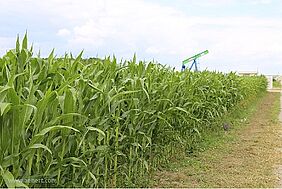Plant seed oil is used in a broad spectrum of applications, ranging from human nutrition to fuel production. Plants are capable of generating and storing triacylglycerol (TAG) in their seeds which delivers the energy and carbon needed for the development of seedlings but might also be harnessed feedstock for fuel production. One of the most frequently used plants for the study of oilseed biology and metabolism, especially in the field of production and accumulation of oil in the leaves and stem, is Arabidopsis thaliana.
Now (2021), scientists at Brookhaven National Laboratory have made a new, possibly ground-breaking discovery concerning an essential component in the formation of oil droplets in Arabidopsis thaliana. They found a sterol related to cholesterol which helped them understand the molecular parameters that control the formation of lipid droplets.
For many years, the team of scientists had already researched the mechanisms of oil accumulation in plant leaves and stems and also created an efficient method to track oil accumulation. By means of genetic engineering, they had managed to design Arabidopsis plants in which a green fluorescent protein was attached to a protein called oleosin. Oleosin only forms on the surface of lipid droplets. If a sample of plant tissue had contained lipid droplets, the fluorescent protein had made it visible as little green dots under a fluorescence microscope.
In the current research, the scientists unexpectedly discovered a sterol in an Arabidopsis strain. The curious thing about this strain was that contained almost no oil. However, it was this circumstance enabled them to find clues to the biochemical factors that drove the process. To make out which mutation was responsible for the reduced oil accumulation, the team of scientists used a technique known as positional cloning. Owing to this technique they were able to pinpoint a specific region in one of the plant’s chromosomes where the mutation was likely to occur. Having performed whole-genome sequencing to search for any mutation in this region, they discovered a gene that might play a decisive part in the process. By selectively eliminating the unmutated version of this gene, the scientists were able to duplicate the effect of the mutation. Therefore, plants with the eliminated gene accumulated no lipid droplets. Adding the unmutated gene back restored oil droplet accumulation. In a second step, they also studied the possible consequences of further upstream mutations of genes from this particular enzyme in the multi-step sterol synthesis pathway and measured sterol levels in these mutants. This made it possible for them to discover the specific type of sterol that, when deficient, was responsible for low oil accumulation. The scientists also carried out quantitative studies in seeds, where lipid droplets are easier to see, to analyse their shapes and sizes, using a transmission electron microscope and a confocal microscope.
Scientists have been researching ways to improve the oil content in energy crops for many years. In 2010, for example, scientists researched WRINKLED1 (WRI1) genes – a key transcriptional regulator involved in the upregulation of fatty acid biosynthesis – in Brassica napus lines with different oil content. To study which effects these genes had on oil content, they identified and sequenced two genes with different lengths. Homology analysis revealed that an 80% content of amino acids in it were homologous to the oil crop gene Arabidopsis thaliana WRI1. Overexpression of Brassica napus wri1 complementary DNAs increased seed oil content by 10-40% and led to enlarged seed size and mass.
In 2017, scientists designed a web-based software package, CRISPR-GE (Genome Editing), which encompassed a toolkit to speed up experimental designs and analyses of mutations for CRISPR/Cas9/Cpf1-based genome editing in plants and other organisms. CRISPR-GE included, for example, a set of tools for the design of target single guide RNAs (targetDesign), prediction of off-target sites (offTarget), design of primers for construction of the single guide RNA expression cassettes and amplification of target site-containing genomic fragments (primerDesign).
There are several advantages to increasing the oil content in stem and leaves as opposed to seeds: leaves compared with seeds are much more abundant as a possible bioenergy material. Also, as the oil in seeds is often used for nutrition, it makes sense to accumulate oil and other bioproducts in the non-seed parts of plants to avoid competition between food and fuel. This study may also serve as a paragon for developing other genetic engineering strategies aimed at boosting the oil content of leaves and stems. Moreover, the findings also apply to the accumulation of oil in plant seeds, where oils naturally occur in plants and could also be used to boost oil production for nutritional purposes.
Having analysed what genes lie at the bottom of low and high oil content in plants, the scientists are convinced that their findings could be used to develop strategies to reactivate these genes and even increase their expression in order to achieve higher oil accumulation in leaves, stems or seeds.
